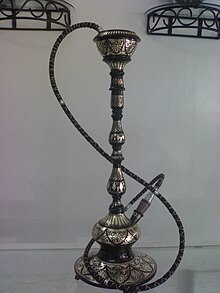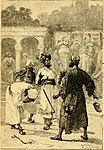Deccanis
Indian Muslim communities |
The Deccanis or Deccani people are an ethnoreligious community of
Following the demise of the Bahmanis, the
The Deccani People are further divided into various groups, most notably the
History
The word Deccani (Persian: دکنی from Prakrit dakkhin "south") was derived in the court of Bahmani rulers in 1487 AD during Sultan Mahmood Shah Bahmani II.[12]
-
A medieval Deccani Muslim horseman
-
Map of the Bahmanid empire
The Bahmanid empire was founded by Hasan Gangu, or also known as Zafar Khan, a ruler of Afghan or Turk origin. following the Rebellion of Ismail Mukh.[13][14][15][16][17][18] Hasan Gangu revolted against the Tughlaq dynasty of the Delhi Sultanate, with the revolt being led by another Afghan, named Ismail Mukh.[19] Ismail Mukh succeeded and then abdicated in favor of Zafar Khan, who founded the Bahmani Sultanate.[19][20] Hasan Gangu was one of the inhabitants of Delhi who were forced to immigrate to Daulatabad in the during the Delhi Sultanate, with the purpose of building a large Muslim urban centre in the Deccan.[21] These North Indian Urdu-speaking immigrants established an independent state, and eventually began adopting a distinct Deccani political identity.[22]
Though few in number, the Deccanis became disproportionately powerful in the Tamil and Telugu country because they included the soldiers and service people who constituted the region's first sizeable Muslim political elite.[23]
The Vijayanagara Wars

The Bahmanids' aggressive confrontation with the two main Hindu kingdoms of the southern Deccan, Warangal and Vijayanagar, made them renowned among Muslims as warriors of the faith.[24] Ahmad Shah Bahmani I conquered Warangal kingdom in 1425, annexing it to the empire. The Vijayanagar empire, which had subdued the Madurai Sultanate after a conflict lasting four decades, found a natural enemy in the Bahmanids of the northern Deccan, over the control of the Godavari-basin, Tungabadhra Doab, and the Marathwada country, although they seldom required a pretext for declaring war.[25] Military conflicts between the Bahmanids and Vijayanagara were almost a regular feature and lasted as long as these kingdoms continued. These military conflicts resulted in widespread devastation of the contested areas by both sides, resulting in considerable loss of life and property.[26] Military slavery involved captured slaves from Vijayanagar and having them embrace a Deccani identity by converting them to Islam and integrating into the host society, so they could begin military careers within the Bahmanid empire. This was the origin of powerful political leaders such as Nizam-ul-Mulk Bahri.[27][28]
Deccan Sultanates
The five
-
The Malik-i Maidan cannon
-
Sultan Hussain Nizam Shah I beheads Rama Raya
-
Ruins of Vijayanagar
Pindaris
The first mention of the Pindaris referred to Muslim mercenaries generally settled in the districts of Bijapur, who had served as mercenaryies for the armies of most of the Muslim Deccani kingdoms. They took part in the numerous wars against the Mughals of Delhi. The disintgeration of the Muslim kingdoms of the Deccan led to the gradual disbandment of the Pindaris. These were at that stage taken in the service of the Marathas. The inclusion of the Pindaris eventually became an indispensable part and parcel of the Maratha army. As a class of freebooters in Maratha armies they acted as a "sort of roving cavalry...rendering them much the same service as the Cossacks for the armies of Russia." The Pindaris would also later be used by kings such as Tipu Sultan.[40]
18th century
Muslim military men with Dakhni background were much sought after by the Marava and Kallar warrior chiefs of the south Indian hinterland. Their fortress towns soon acquired concentrations of migrant Dakhnis and Urdu-speaking service people, mostly Sunnis. These incomers included seasoned fighters who had seen service with the Mughals and the Muslim states in northern India.[23] This was the source of the phenomenal rise of rulers such as Hyder Ali and Tipu Sultan.
Sultanat-i-Khudadad of Mysore
Hyder Ali had initially served as an ordinary soldier for the Hindu Wadeyar
-
Territories of the original Wadeyar kingdom
-
Hyder's Dominions in 1780
-
Hyder Ali as 'The Pretended Fakir'
-
Sir David Baird Discovering Body of Tipu Sultan
Culture
Painting

Handicraft

The craftspersons of Bidar were so famed for their inlay work on copper and silver that it came to be known as
See also
Further reading
- Urban Culture of Medieval Deccan (1300 A.D. TO 1650 A.D.)
- Bulletin of the Deccan College Post-Graduate and Research Institute, Volume 22 (1963)
References
- ^ "Deccani population statistics, 2011".
- ^ "Kya ba so ba – Learning to speak south-indian urdu". www.zanyoutbursts.com. Retrieved 18 March 2016.
- ISBN 978-93-5199-083-3.
- ^ "Āfāqī | people | Britannica". www.britannica.com. Retrieved 25 October 2023.
- ISBN 978-1-4008-6815-5.
- S2CID 161064253.
- ^ "Bahmani sultanate | historical Muslim state, India". Encyclopædia Britannica. Retrieved 18 March 2016.
- ^ "Sultans of Deccan India, 1500-1700 Opulence and Fantasy | The Metropolitan Museum of Art". metmuseum.org. Retrieved 18 March 2016.
- ^ "Urdu is the 2nd most spoken language in 5 states". The Siasat Daily. 2 September 2019. Retrieved 4 March 2021.
- ISBN 978-8121507400. Retrieved 11 May 2016.
- ISBN 9780804754422.
- ISBN 9788123023151. Retrieved 13 January 2020.
- ISBN 9781476608884.
Zafar Khan alias Alauddin Hasan Gangu ('Ala al-Din Hasan Bahman Shah), an Afghan or a Turk soldier, revolted against Delhi and established the Muslim Kingdom of Bahmani on August 3 in the South (Madura) and ruled as Sultan Alauddin Bahman Shah.
- ISBN 9780415329200.
The Bahmani sultanate of the Deccan Soon after Muhammad Tughluq left Daulatabad, the city was conquered by Zafar Khan, a Turkish or Afghan officer of unknown descent, had earlier participated in a mutiny of troops in Gujarat.
- ISBN 9781108417747.
- ISBN 9781843449232.
In the early fourteenth century, the Muslim Bahmani kingdom of the Deccan emerged following Alauddin's conquest of the south. Zafar Khan, an Afghan general and governor appointed by Sultan Muhammad bin Tughluq, was victorious against the troops of the Delhi Sultanate, establishing the Bahmani kingdom with its capital at Ahsanabad (modern-day Gulbarga).
- ISBN 9783743414709.
Some Authors write that he was descended from Bahman, one of the ancient kings of Persia. And I have seen a pedigree of him, fo derived (?), in the royal library of Ahmednagar: but am inclined to believe, such lineage was only framed upon his accession to royalty, by flatterers and poets, and that his origin is too obscure to be authentically traced. The apellation of Bahmani, he certainly took in compliment to Kango Brahmin, which is often pronounced Bhamen, and by tribe he was an Afghan.
- ISBN 9781843449232.
- ^ ISBN 9789332500983.
- ^ Ibrahim Khan (1960). Anecdotes from Islam. M. Ashraf.
- ISBN 9788171545797.
- ISBN 9781351393997.
- ^ ISBN 9781136818011.
- ISBN 0300064659.)
{{cite book}}: CS1 maint: multiple names: authors list (link - ISBN 9789004097940.
- ^ Medieval India UPSC Preparation Books History Series. Mocktime Publication. 2011.
- ISBN 9780521254847.
- ISBN 9781474436090.
- ISBN 9781838609283.
- ISBN 9781474436090.
- ^ Sakkottai Krishnaswami Aiyangar (1951). Ancient India and South Indian History & Culture. Oriental Book Agency. p. 81.
- ^ Thomas Wolseley Haig · (101). Historic Landmarks of the Deccan. Pioneer Press. p. 6.
- ISBN 9780300211108.
- ISBN 9788125004851.
- ISBN 9781611680195.
- ISBN 9780521254847.
- ISBN 9788126901234.
- ISBN 9780865439801.
- ISBN 978-0-674-06736-3.
- ^ Roy, M.P. (1973). Origin growth and suppression of the Pindaris.
- ISBN 9781932705546.
- ISBN 9781514494615.
- ^ Deccani painting, britannica.com, 10 April 2012
- ISBN 0-85667-153-3.
- ^ a b c "Proving their mettle in metal craft". The Times of India. 2 January 2012. Archived from the original on 8 May 2013. Retrieved 2 January 2012.
- ^ "Karnataka tableau to feature Bidriware". The Hindu. 11 January 2011. Retrieved 6 March 2015.









